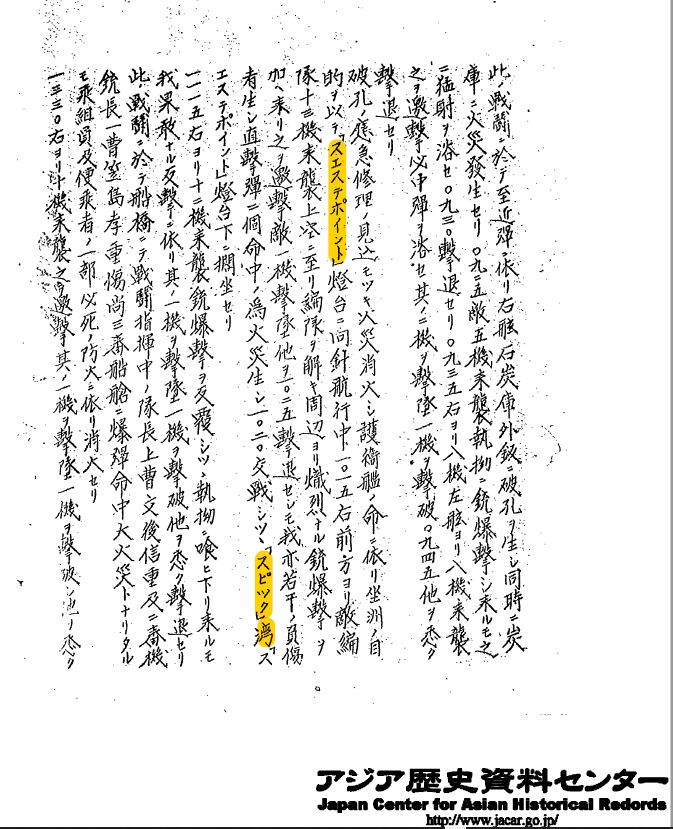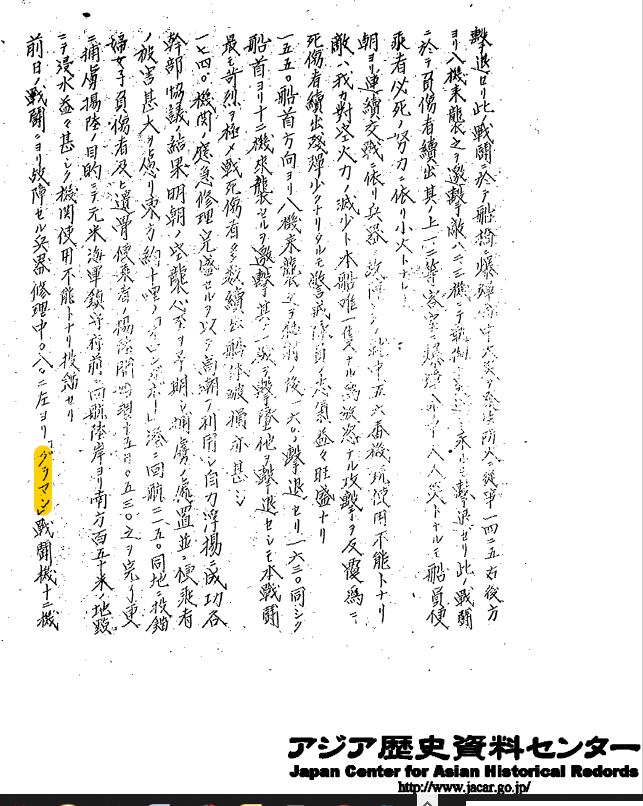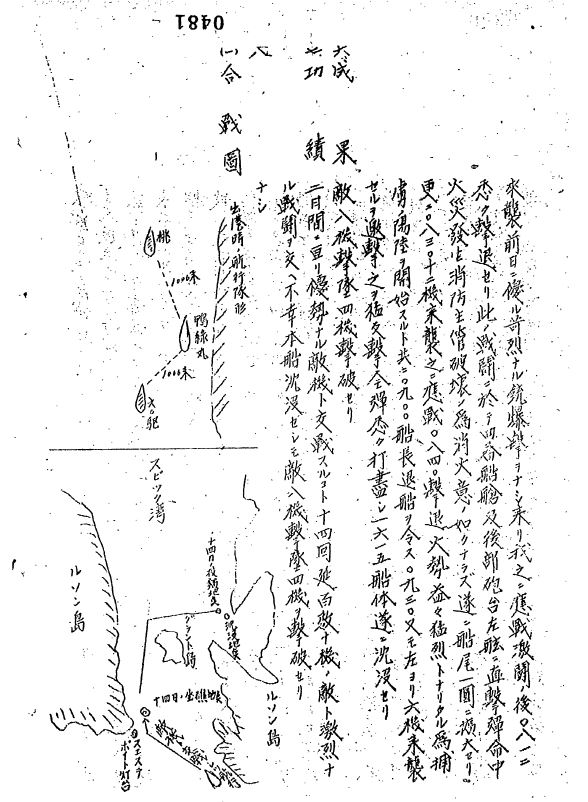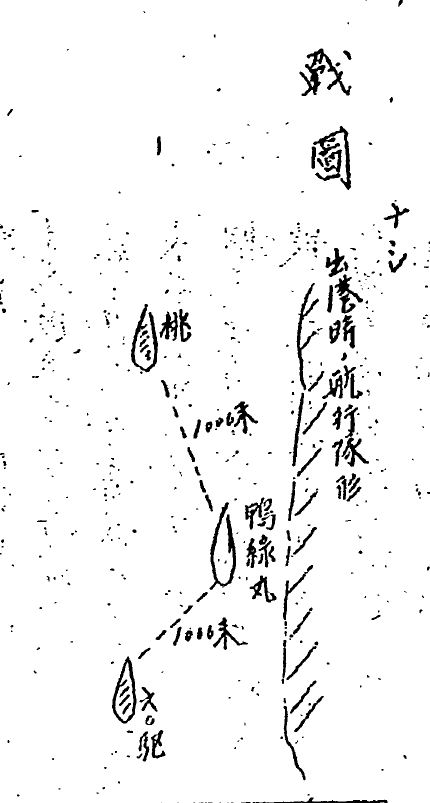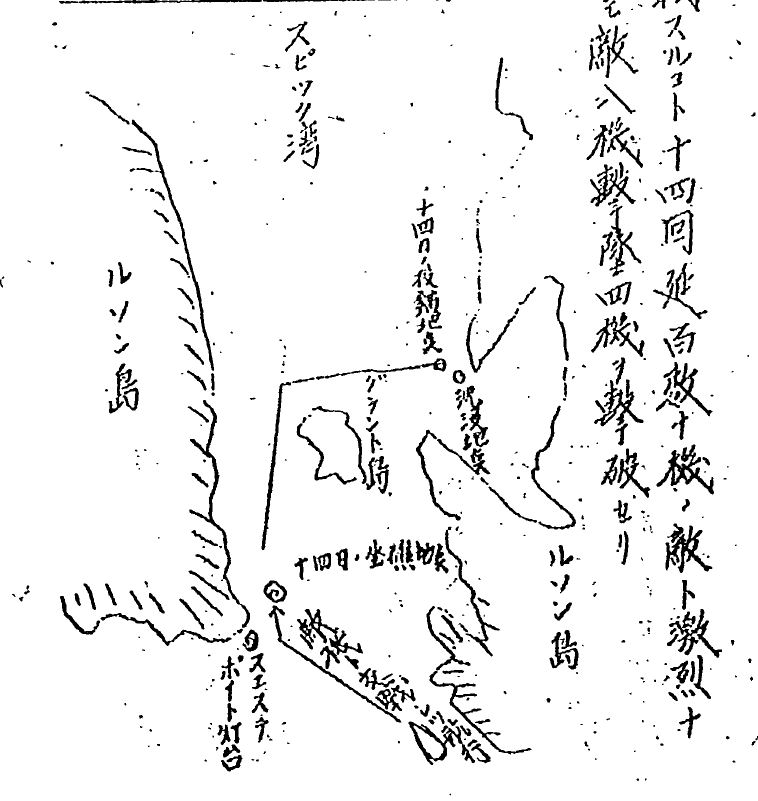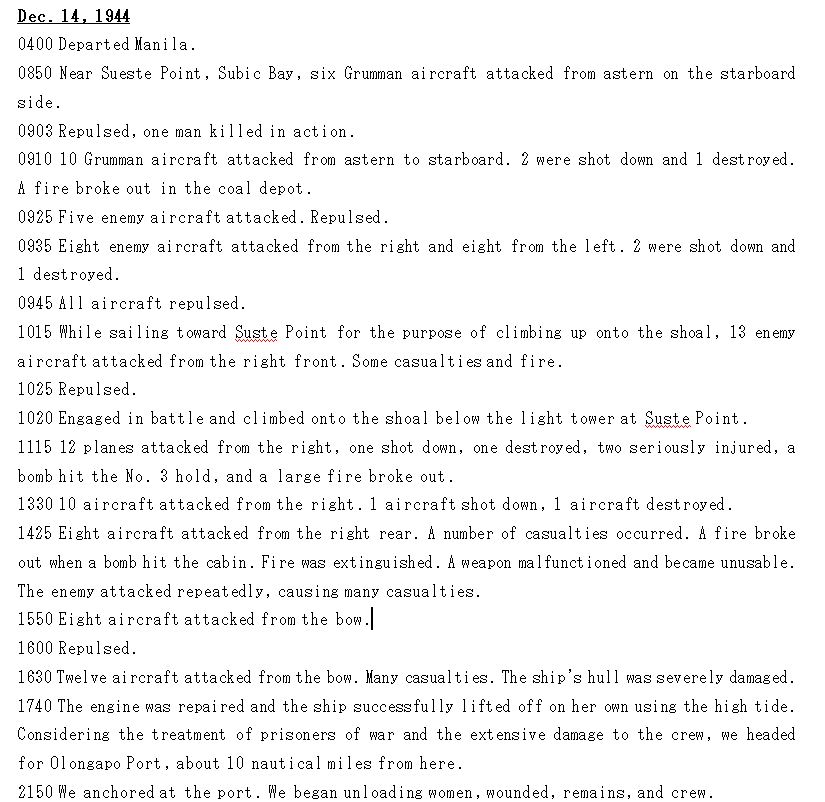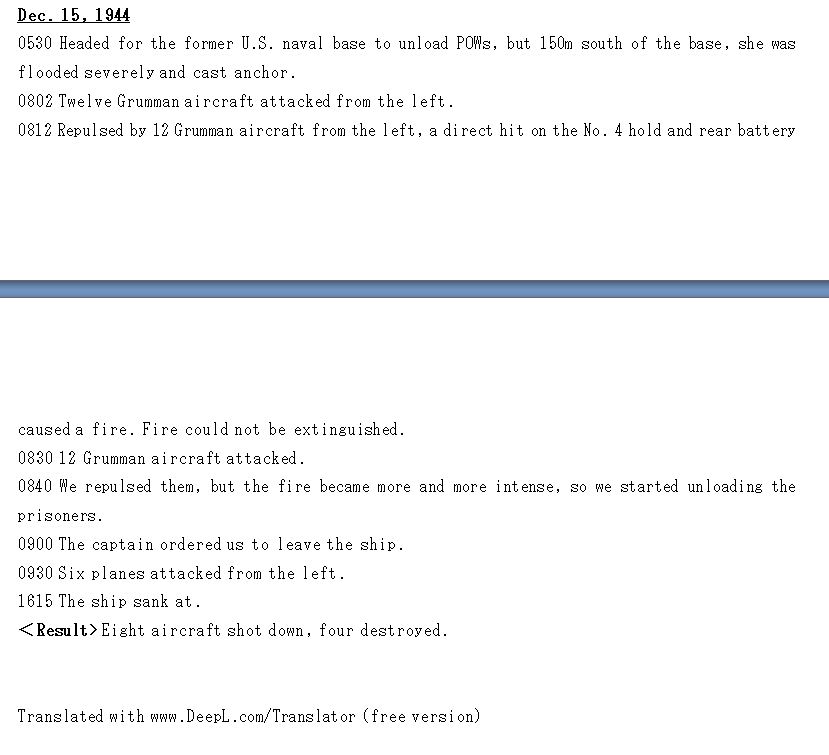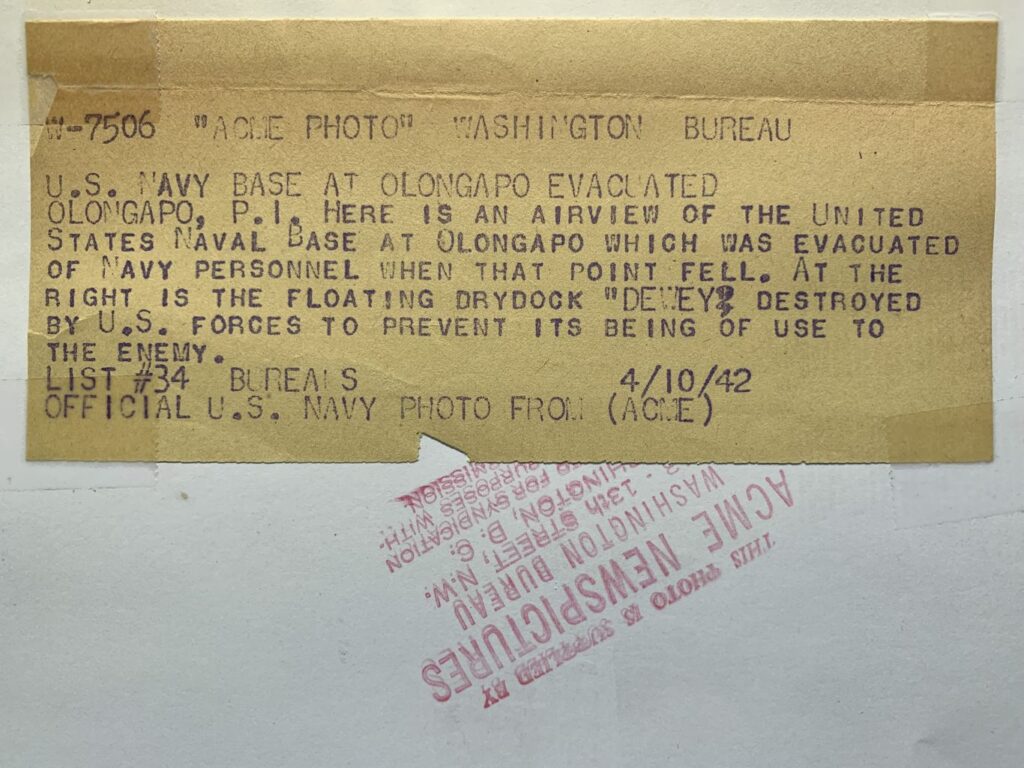
Zo691-01. 1941 Olongapo, Chet Britt Sr.at the Olongapo Fleet Boat Landing and Waiting Shed. It looks like the Army Coastal Defense Force of Fort Wint on Grande Island in Subic Bay used the same boat landing area as the US Fleet in the Olongapo US Naval Station. This image was provided by John Duresky.
————————————————–
Army Lt Chester K Britt, was one of 1,619 POWs that were on the Oryoku Maru. Lt Britt was first assigned to Fort Wint on Grande Island in 1940, then when it was abandoned on about December 24, 1941, he fought on Bataan, was on the Bataan Death March, then spent the next 2-1/2 years at Camp O’Donnell, Cabanatuan, Davao Penal Colony, and Bilibid Prison which he left at the end to board the Oryoku Maru. He survived the Oryoku Maru, then the Enoura Maru, then the Brazil Maru, then 3 months at Fukuoka POW Camp #3, then almost 4 months at the POW camp in Mukden Manchuria. He was freed on August 16, 1945. He died in 1953 due to health problems from his time as a POW. When he died my friend was only four years old. This is Lt Britt’s memorial page from West Point. He graduated on June 11, 1940 or click here:
Lt Col David Britt, USAF (Ret), Lt Britt’s son and family loved and cherished him!
John Duresky is the friend of Lt Col David Britt, USAF (Ret) and he is going to write a book about Army Lt Chester K Britt.
Karl-Wilhelm Welteke is a retired USN Sailor and resident of Olongapo. During his research, John Duresky asked me for information and we shared them. He found some interesting pictures and gave me permission to use them. I posted them in my Flickr account also because you can download them in high resolution there and will be able to read or view them properly; links are provided!
———————————————————
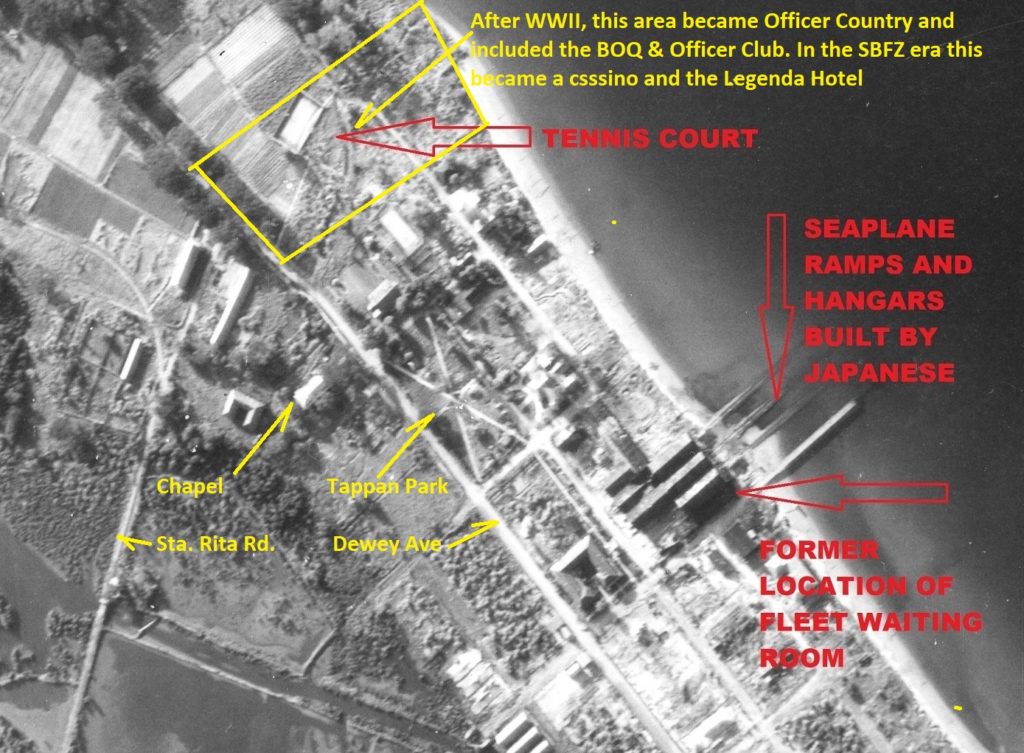
Zo692-02. A cropped image of a US. WWII reconnaissance image of the Olongapo Naval Station under Imperial Japanese occupation. The red markings are from John Duresky and the yellow markings are from Karl Welteke. This image was provided by John Duresky.
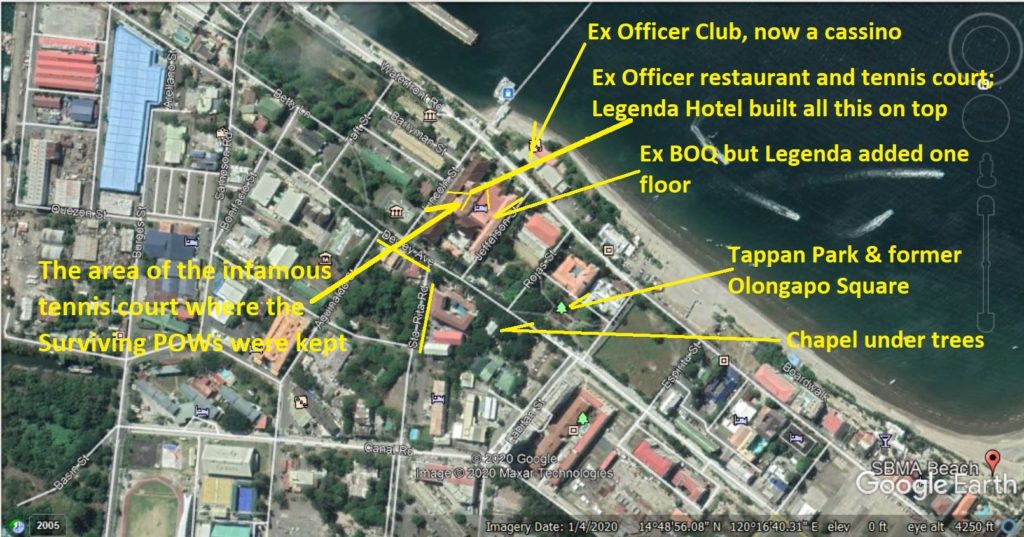
Zo693-03. A Google Earth image of the former Olongapo Naval Station, then the Subic Bay Naval Base and now the Subic Bay Freeport Zone (SBFZ). The Tappan Park, then and now, (also was the Olongapo Square) is the clearest landmark (prewar & postwar) to identify areas today and in the past!
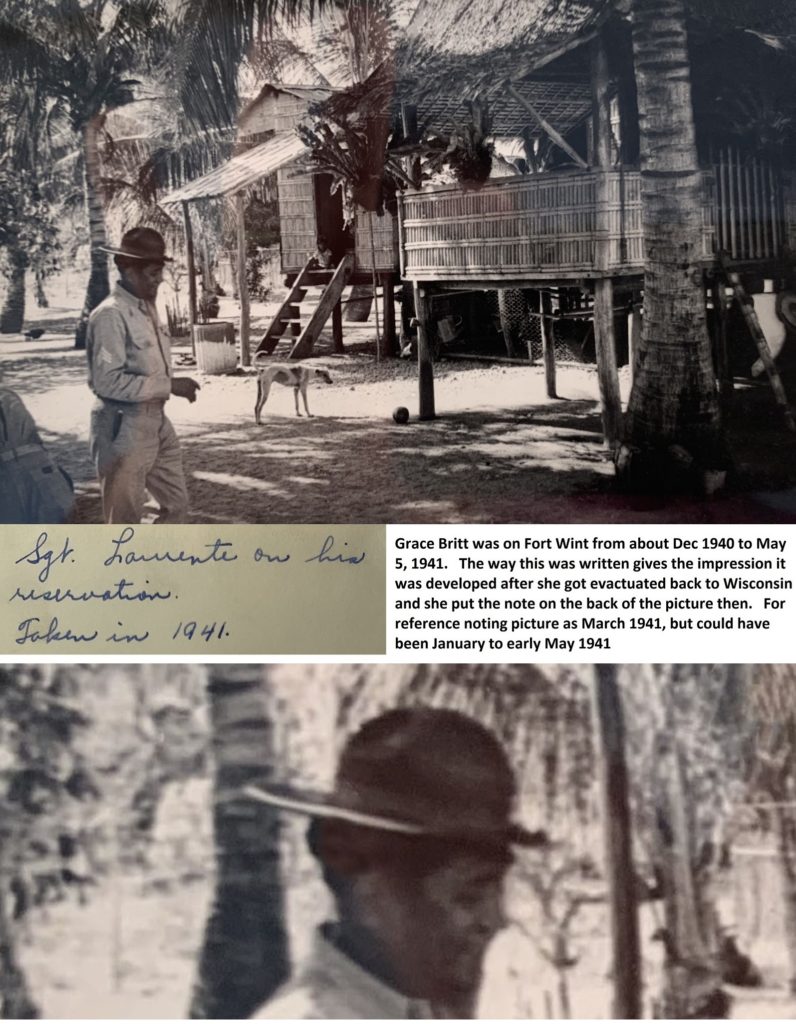
Zo694-04. 1941 3 Sgt. Laurente on his reservation on Fort Wint view 1. This is one of two pictures from the Britt family collection. It seems that the spouse of Lt. Britt visited in 1941. The fort was manned by US Philippine Scouts and Philippine Army Coastal Defense Forces with US Officer in the leading position. In 1941 it was mainly used as a training facility. I like the picture because it shows a berthing facility. This image was provided by John Duresky.
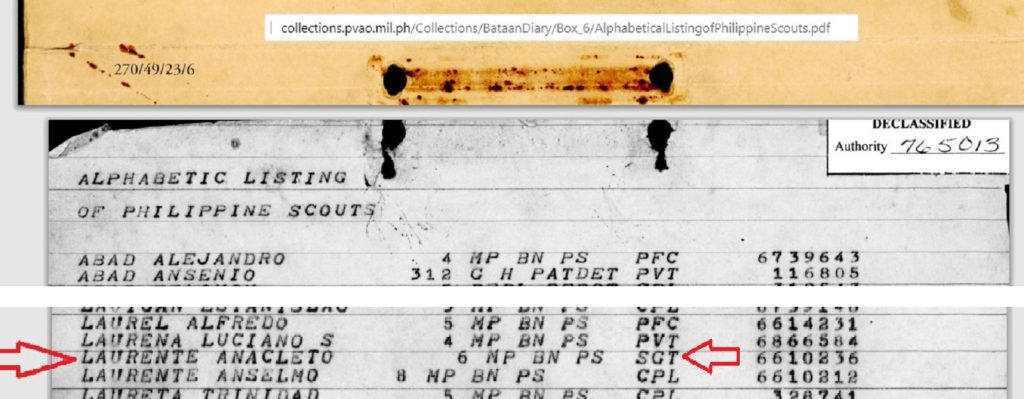
Zo695-05. 1941 3 Sgt. Laurente on his reservation on Fort Wint view 1. This is one of two pictures from the Britt family collection. It seems that the spouse of Lt. Britt visited in 1941. The fort was manned by US Philippine Scouts and Philippine Army Coastal Defense Forces with US Officer in the leading position. In 1941 it was mainly used as a training facility. I like the picture because it shows a berthing facility of the time before the War. This image was provided by John Duresky.
Dave Britt, he wrote this to John Duresky, about how his father Lt Britt and Sgt Laurente may have interacted first at Fort Wint on Grande Island and then on Bataan:
“My guess is that the Filipino Sgt was a part of the force evacuated to Bataan to fight with the scouts. Since Mom knew him; he must have been associated with Dad in the training business, which is what they were doing on the Ft Wint post until the war began.
He may have been the First Sgt for the 92nd CAC Battalion, at least the Filipino element of the unit.
Remember, Dad fought with Filipino Scouts, except for a few American officers as battery commanders, the guys that manned the guns were all Scouts. Probably the 500 trainees from the classes at Ft Wint.
One of the hats Dad wore was HQ company commander, so he had responsibilities for post maintenance. Maybe the Sgt was his 1st Shirt for this unit, comprised of Filipino soldiers most likely.
I wonder if he (Sgt Laurente) survived the war?” – Dave Britt
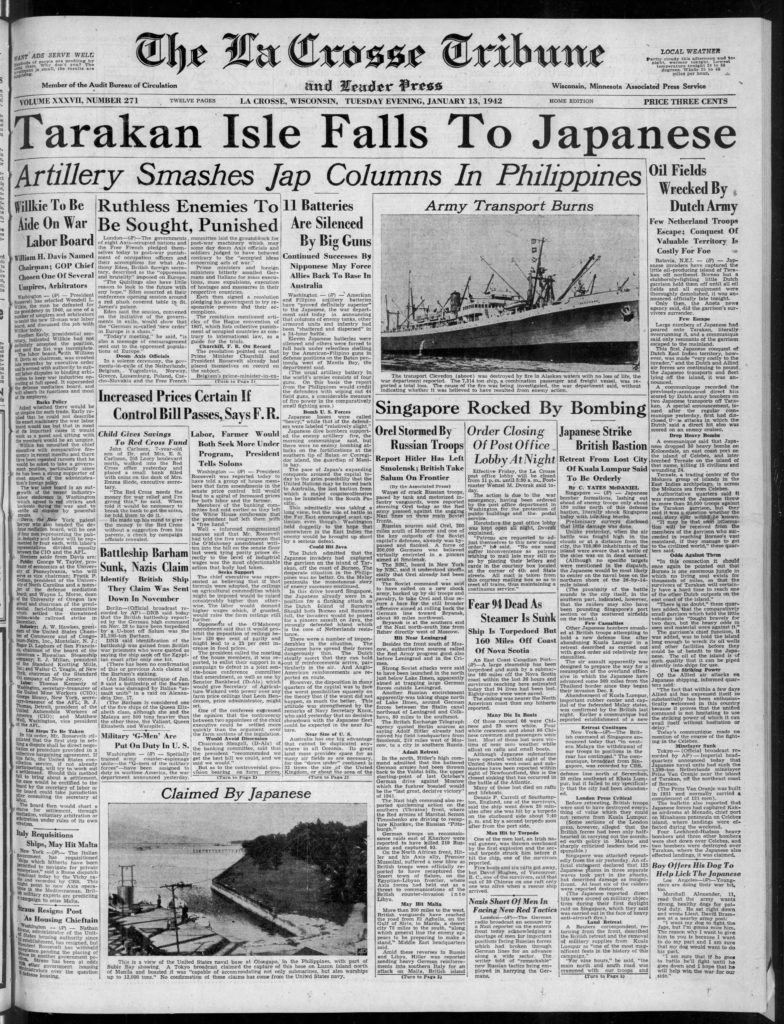
Zo696-06. This is one of two newspaper clippings about the capture of the Olongapo Naval Station by the Japanese Imperial Forces with pictures of the Naval Station in 1942. This is the main reason I upload them here into the Flickr account because you will be able to download them in high resolution. These pictures were found by John Duresky for his project to write a book about Army Lt Chester K Britt, a victim of the Imperial Japanese Hell Ship Oryoku Maru. This image was provided by John Duresky. To download it in high resolution, click here:
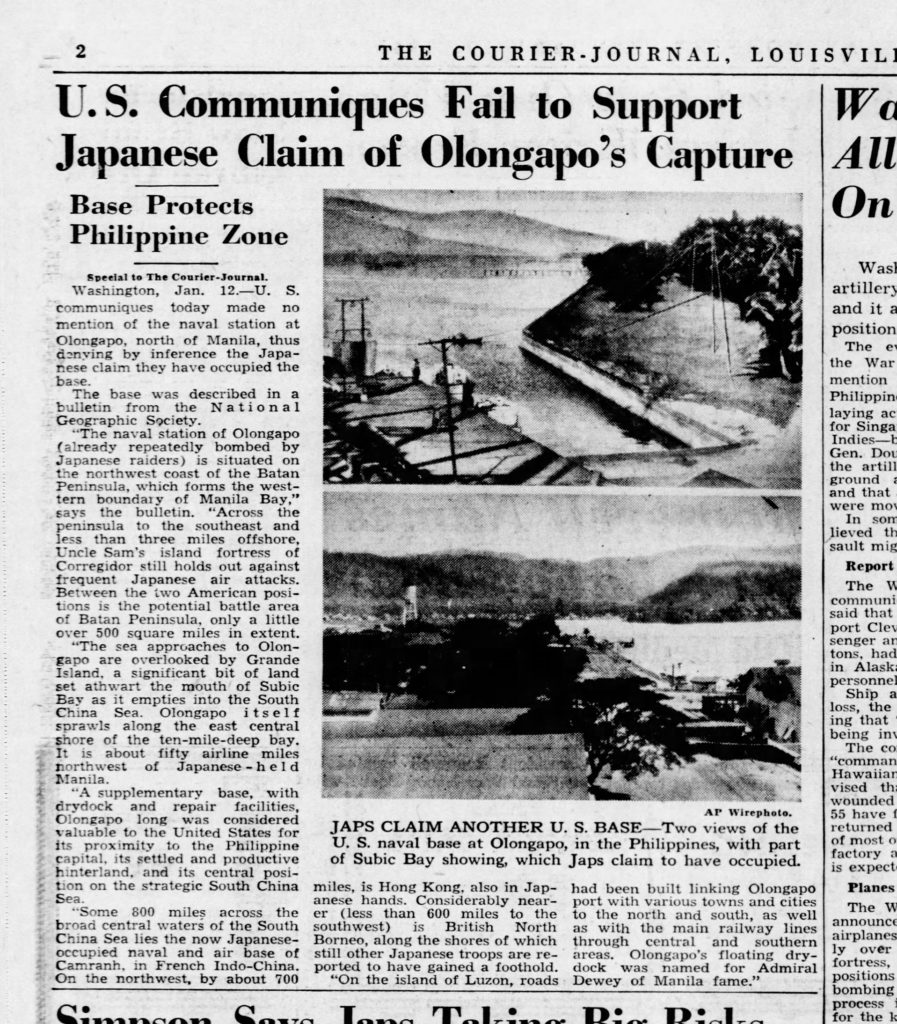
Zo697-07. This is one of two newspaper clippings about the capture of the Olongapo Naval Station by the Japanese Imperial Forces with pictures of the Naval Station in 1942. This is the main reason I uploaded them here into the Flickr account because you will be able to download them in high resolution. These pictures were found by John Duresky for his project to write a book about Army Lt Chester K Britt, a victim of the Imperial Japanese Hell Ship Oryoku Maru. This image was provided by John Duresky. To download it in high resolution, click here:
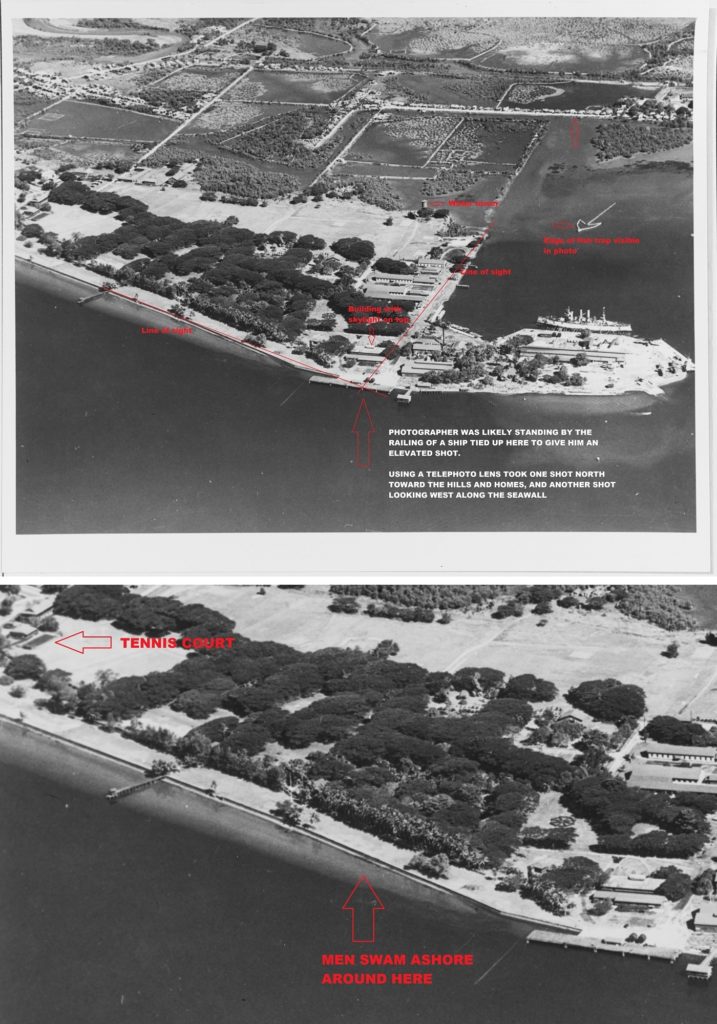
Zo698-08. This is an excellent picture of the Olongapo Naval Station and the Naval Yard at right. When was it shot? Where is the floating Drydock Dewey? Was it shot after the Dewey was towed to Mariveles? A 2nd picture is the zoomed in area where the Oryoku Maru survivors had to shim to. Also it shows a boat landing slip, which is zoomed-in in a later image. Somewhere under the trees is also the Spanish Gate, the other important landmark, then and today, but it is hidden under the trees. The USS Rochester is still there before it was scuttled. It was used as the base power plant! This image was provided by John Duresky. This is a paragraph from this Wikipedia URL or click here:
https://en.wikipedia.org/wiki/USS_New_York_(ACR-2)
Rochester departed Balboa on 25 February 1932 for service in the Pacific Fleet. She arrived Shanghai on 27 April, to join the fleet in the Yangtze River in June and remained there until steaming to Cavite, to decommission on 29 April 1933. She would remain moored at the Olongapo Shipyard at Subic Bay for the next eight years. Her name was struck from the Naval Vessel Register on 28 October 1938, and she was scuttled on 24 December 1941 to prevent her capture by the Japanese.

Zo699-09. This double picture shows: first, the zoomed in boat slip, and then a view of the Navy Yard Olongapo, in the north Direction. In the previous picture, John Duresky marked in, the directions of the sighting of these two pictures. This image was provided by John Duresky.
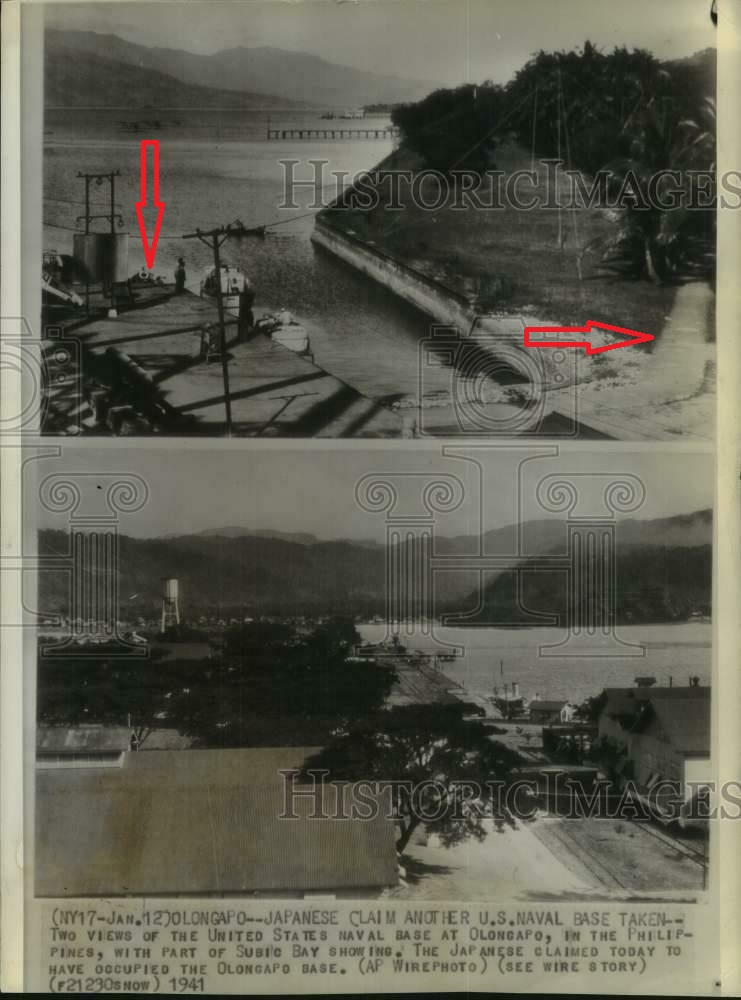
Zo700-10. The same picture as the last one, under the down pointing arrow, John believes, that could be an Oryoku Mary life boat. This image was provided by John Duresky.
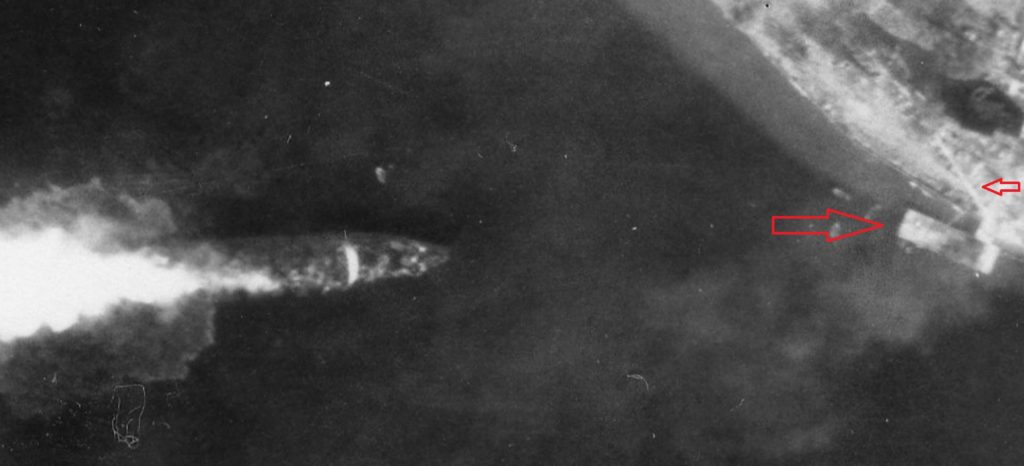
Zo701-11. The Oryoku Mary burning and the picture shows the boat slip which is a good landmark. John sent this image for comparison. This image was provided by John Duresky.
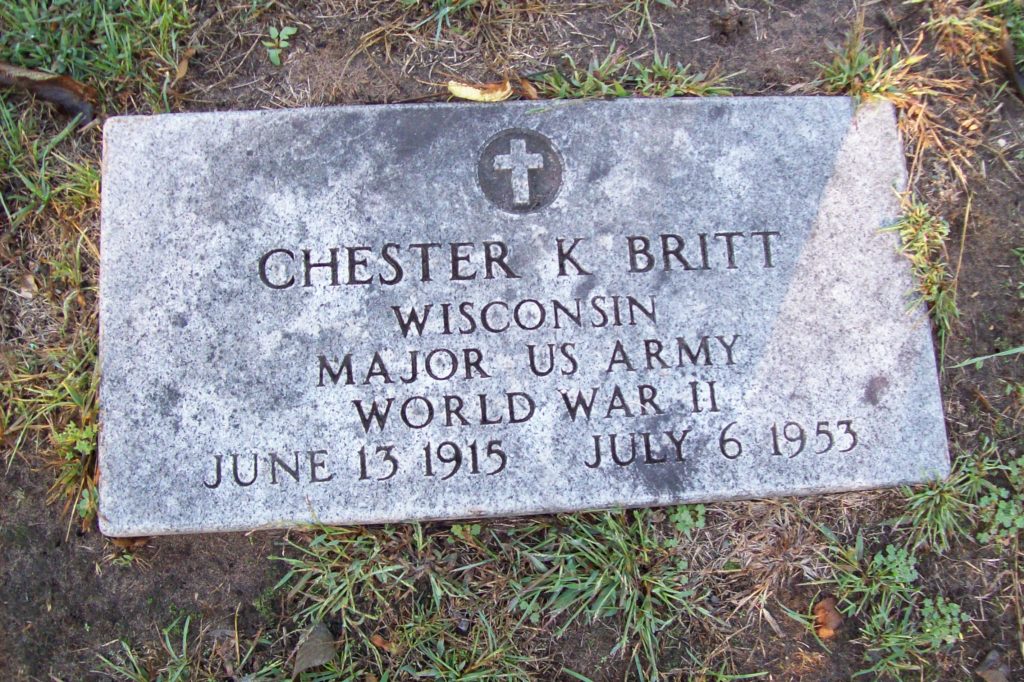
Zo702-12. The grave of WWII Army Lt Chester K Britt. This is the story of one man of millions and millions, who paid a heavy price in the struggle for freedom in WWII. This image was provided by John Duresky.
Note from Karl: All pictures can be downloaded in high resolution if you go to this Flickr album, click here:
- More information about the Oryoku Maru
From: John Duresky, who is a member of the Army Lt. Chester K. Britt Research Team. We have this forum page URL about the Army Lt. Chester K. Britt book project, or click here:
https://corregidor.proboards.com/thread/2275/army-chester-britt-ship-oryoku
John wrote me this on the 13th July 2020:
Karl, check this out or click here:
http://y294ma.livedoor.blog/archives/17965797.html
I’ve become friends with this blogger in Japan, Mr. Yasuhiro Fukushima. He was 7 when his father died of Malaria at a hospital on Kyushu in 1943 after being evacuated from Rabaul, he was a sergeant in the IJA who never saw combat. He has been very helpful. Don’t know if I told you, but I speak pretty good Japanese after living there for 5 years and going there numerous times on business, and I have traveled all over the country.
The painting of the sailors on the beach on December 14 could very well be the beach in your photos. Angle is even right in the painting comparing the angle of the ship in the photos to the beach in front of the bow. Note the anchor chain in the painting of the Oryoku Maru. Also, in background I’m assuming is the destroyer MOMO also under attack. Drawing of the deck gun in action is at Olongapo on the 15th. Bottom painting shows it assisting in the rescue of another ship, the Fuji Maru earlier in the war.
This website says about December 14 (or click here)
https://www.archives.gov/publications/prologue/2003/winter/hell-ships-1.html
“….The POWs endured seventeen such attacks before sunset. Only Oryoku Maru remained afloat. All other craft were sunk or departed…..”
Do you know if any wreck has ever been identified with the attack around Sueste Point that might be from the battle that day? I’m certain the MOMO and sub chaser #60 escaped, so this would be some smaller ship.
Thanks,
John
Here is just one sample image, a painting, from the Japanese blogger! There are more, however the text is in Japanese.
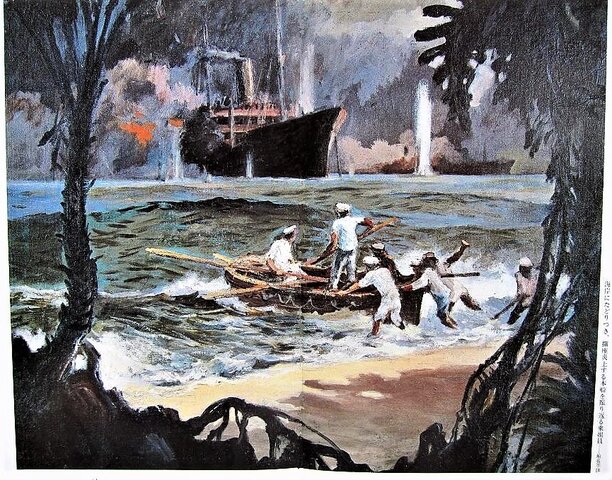
Zo829. This picture came from the Japanese Blog of Mr. Yasuhiro Fukushima. This shows a Japanese boat from the Oryoku Maru on the beach, under Sueste Point, at the entrance to Subic Bay on the 14th of Dec. 1944. Look at the full text from John Duresky and for the Blog URL above.
Now here are just a few short paragraphs (about the Oryoku Maru) from the NARA webpage about: “American POWs on Japanese Ships Take a Voyage into Hell, Part 1”.
During a lull in Allied air attacks, the Japanese ordered American medical officers at Bilibid Prison to examine and prepare a list of all prisoners who could depart with the last of the POW transports. On the morning of December 12, the roll was read. That evening the departees bade farewell to friends and packed what little remained of their belongings. They were awakened at 4 a.m. the following morning, fed a bit of breakfast, and then all 1,619 POWs marched to Manila’s Pier 7. Awaiting them was the Oryoku Maru, its name dimly visible through battleship-gray paint. No Red Cross or other markings were apparent to distinguish her from any other combat craft. The ship bristled with antiaircraft guns.
Oryoku Maru’s cargo included the “4th Medium Mortar Battalion, consisting of 23 officers and 535 non-commissioned officers and troops, 1350 cases of unit baggage, 12 artillery pieces, 2430 cases of ammunition . . . 14 cases of gasoline, four trucks,” and many more reinforcements and supplies. An intercept of December 13 announced, “Oryoku Maru is part of convoy with 2054 troops aboard.” The ship was to be loaded and ready to sail with the MATA-37 convoy on December 14. On that date, the Brazil Maru and Enoura Maru prepared to sail from Takao to Manila.
Huddled together, seeking emotional refuge from the “terrific explosions and concussions,” according to Jacobs, the prisoners “were shaken about like a dog shakes a rat.” They “were covered with rust chips and bomb dust.” Between raids, they tended the wounded with what scanty supplies were left. Some tried to eat the now dirty rice but found they had lost their appetites. From the depths of this inferno came the voice of Father Duffy praying, “Forgive them. They know not what they do.”
Above the holds, gun crews stood and died at their guns. Their blood trickled over the deck and into the holds. New crews replaced the fallen, just as the next flight dived and strafed the decks. The spray of bullets was quickly succeeded by the detonations of bombs that “bounced” the ship about “like a cork in a tub.” In futile defiance, the Japanese gun crew officer shook his spear at the onrushing planes.
The book is finished now!
Relentless Hope: A True Story of War and Survival, by David L. Britt
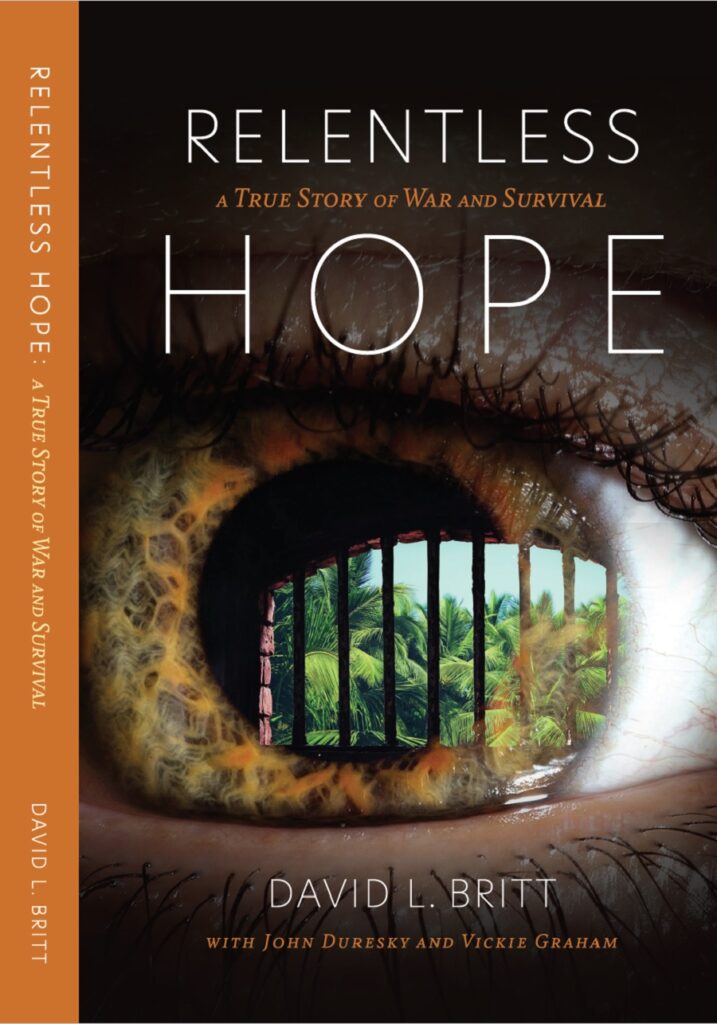
Zf192. Relentless Hope: A True Story of War and Survival, by David L. Britt, this is the front cover.
A new book about Army Lt. Britt serving in Fort Wint, (Grande Island in Subic Bay) and in the Battle of Bataan during WWII. He also survived three Hell Ships and being a POW in the merciless hands of the Japanese Imperial Army.

Zf194. 1941 Olongapo, Chet Britt Sr. at the Olongapo Fleet Boat Landing and Waiting Shed. It looks like the Army Coastal Defense Force of Fort Wint on Grande Island in Subic Bay used the same boat landing area as the US Fleet in the Olongapo US Naval Station. This image was provided by John Duresky.
The printed book is now available Relentless Hope: A True Story of War and Survival by David L Britt, with John Duresky and Vickie Graham ISBN 978-1-09838-539-2 It’s online for pre-sale print-on-demand, and you need to pre-order to get a copy printed and shipped to you. It won’t be until the box vendors see a good sales volume that they will order paper copies for display and sale in stores.
Bookbaby has the best write-up, click here:
Barnes and Noble, click here.
It is also available at Amazon.com, click here:
For the Amazon picture page, you can directly click here:
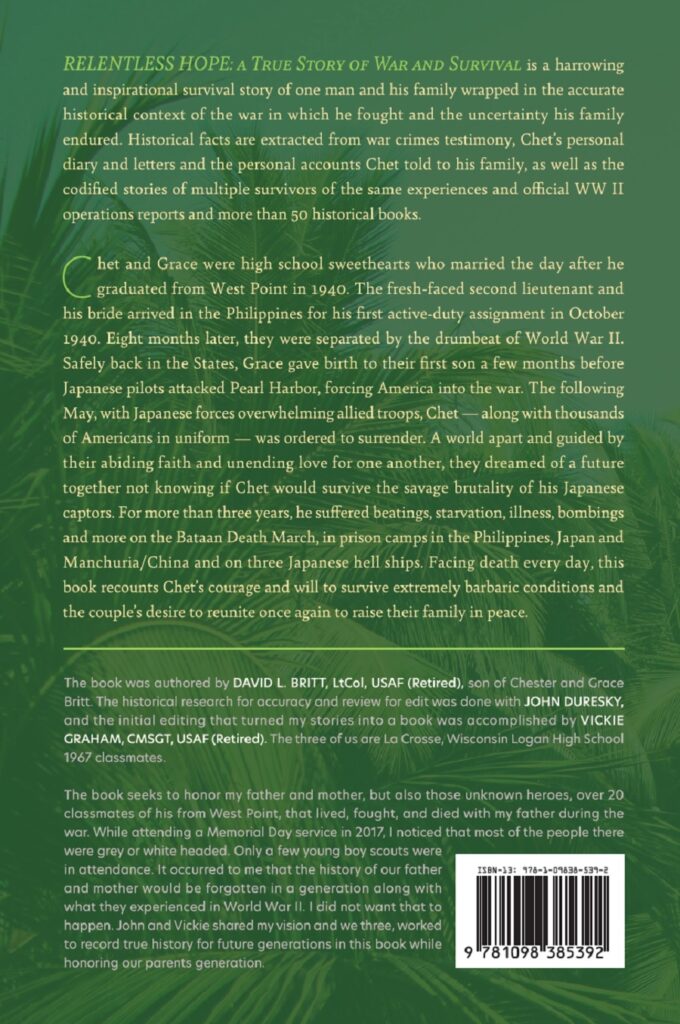
Zf193. Relentless Hope: A True Story of War and Survival, by David L. Britt, this is the back cover.
The Army Lt. Chester K. Britt Research Team had contacted Corregidor Forum members for information about Fort Wint, Grande Island, Olongapo, Bataan and Corregidor. We helped them and they shared some of their research finds with us which some of it is already posted in the Corregidor Forum.
The people of the Army Lt. Chester K. Britt Research Team are:
First are Dave Britt, LTC USAF (Ret), son of Chester K Britt, Vickie Graham CMSGT USAF (Ret), and John Duresky. They all graduated from Logan High School in La Crosse, Wisconsin in 1967, and are doing it as a team. Chester Britt graduated from Logan in 1933 and his mother Grace in 1934. Dave wrote most of the manuscript, John editing what he wrote and doing most of the research, and Vickie is the final editor with about 20 years of professional writing in her resume, largely with Airman Magazine.
They have finished the book about Army Lt. Chester K. Britt now! We posted that news into this new forum page, click here:
——————————————–
Added 2 images
The Naval Station Olongapo Fleet Waiting Room, pre war.
This is where the Fleet Waiting Room must have been.
The Army Lt. Chester K. Britt Book authors are sure about the location and I agree whole heartily.
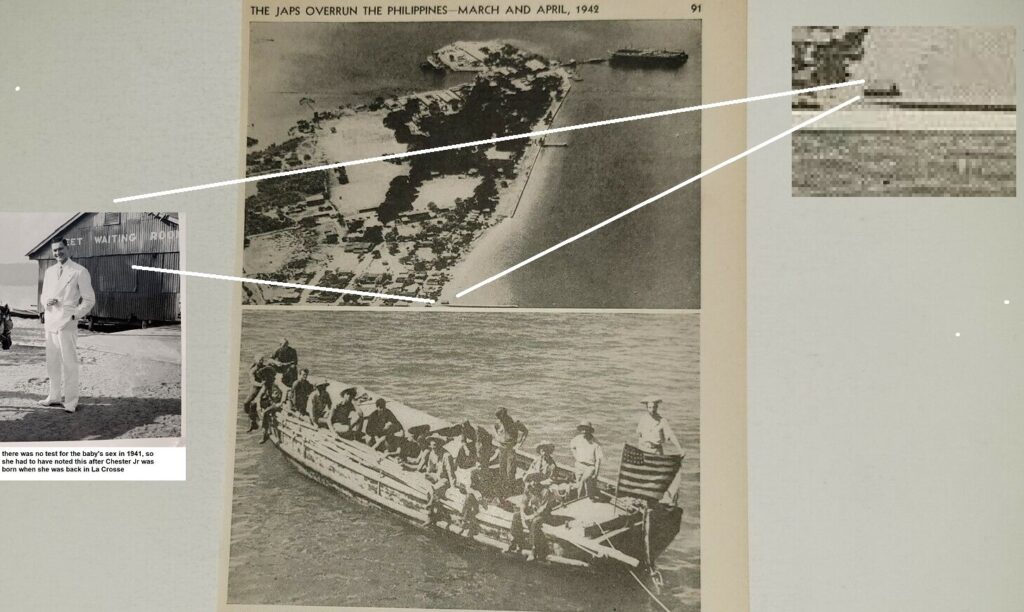
Zf238, The Naval Station Olongapo Fleet Waiting Room, pre war. The picture was provided by the Army Lt. Chester K. Britt Book authors.

Zf239. The Naval Station Olongapo Fleet Waiting Room, pre war, zoomed in. The picture was provided by the Army Lt. Chester K. Britt Book authors. This was a file photo because the Dry Dock George Dewey was not in Olongapo/Subic Bay anymore in 1942.
————————————————
Japanese after action report of attacks on Oryoku Maru.
New Book: Relentless Hope: A True Story of War and Survival, by David L. Britt
One of the members of the research team, who wrote the above book, shared this information with the Corregidor.org Team.
28th Aug. 2021
Paul, John and Karl
One of you might want to add this Japanese after action report of attacks on Oryoku Maru your websites. (From Karl: only pages 38 to 42 have been reproduced here).
I found this in the JACAR archives in Japan. On page 38 to 42 is the Japanese after-action report of the attacks on the Oryoku Maru. Sketches show the Oryoku Maru being first led by the destroyer MOMO 1000 meters in front and trailed by the sub chaser CH-60 1000 meters astern. Other sketch shows it taking a hard right turn after it left Sueste Point and passed Grande Island. Some serious puffery going on about the number of planes shot down, but gives some interesting details about the action, number of Japanese civilians, and damage to the ship from the attacks, etc. I could tell what it was, but way beyond my limited Japanese language ability, so I sent it to Ms Taeko Sasamoto at the POW Research Network Japan who did the attached translation. At a minimum, it’s probably the most detailed report of the attacks from the Japanese viewpoint on the ship, as opposed to reports by the POWs of what they were hearing from 40 feet below the main deck.
John
Here are 9 images of pages 38 to 42, 2 sketches zoomed in and the 2-page translation from Ms Taeko Sasamoto at the POW Research Network Japan which was arranged by John Duresky.
Zf244. Page 38 of the Japanese after action report of attacks on Oryoku Maru provided by John Duresky of the new book author team: Relentless Hope: A True Story of War and Survival, by David L. Britt
Zf245. Page 39 of the Japanese after action report of attacks on Oryoku Maru provided by John Duresky of the new book author team: Relentless Hope: A True Story of War and Survival, by David L. Britt
Zf246. Page 40 of the Japanese after action report of attacks on Oryoku Maru provided by John Duresky of the new book author team: Relentless Hope: A True Story of War and Survival, by David L. Britt
Zf247. Page 41 of the Japanese after action report of attacks on Oryoku Maru provided by John Duresky of the new book author team: Relentless Hope: A True Story of War and Survival, by David L. Britt
Zf248. Page 41a (the first zoomed in sketch) of the Japanese after action report of attacks on Oryoku Maru provided by John Duresky of the new book author team: Relentless Hope: A True Story of War and Survival, by David L. Britt.
Zf249. Page 41a (the second zoomed in sketch) of the Japanese after action report of attacks on Oryoku Maru provided by John Duresky of the new book author team: Relentless Hope: A True Story of War and Survival, by David L. Britt.
Zf250. Page 42 of the Japanese after action report of attacks on Oryoku Maru provided by John Duresky of the new book author team: Relentless Hope: A True Story of War and Survival, by David L. Britt
Zf251. -pg1 of 2. Translation by Ms Taeko Sasamoto at the POW Research Network Japan of the Detailed Engagement Report of the Oryoku Maru.
Zf252-pg2 of 2. Translation by Ms Taeko Sasamoto at the POW Research Network Japan of the Detailed Engagement Report of the Oryoku Maru.
f316. No. 13.1942 4 10 OLONGAPO wirephoto view 1
This is a pre WWII image of the Naval Station Olongapo in Subic Bay. The original, a marked-up copy, 3 zoomed/cropped pieces and the back of the picture source description are also posted here in high resolution, in this Flickr album, scroll down, click here:
This picture was bought in the www by the Army Lt. Chester K. Britt Research Team. They completed their book, called: Relentless Hope: A True Story of War and Survival, by David L. Britt
Lt Britt was an Army Officer assigned to Fort Wint on Grande Island in Subic Bay. When the Philippine and American Forces abandoned the Subic Bay area Lt. Britt took his Philippine Scouts and Philippine Army Soldiers to Bataan with their 155mm GPF artillery guns and fought there to the end.
This Army Officer survived as a POW of the Japanese, rides on 3 Hell Ships and continued his active duty in the Army. That is what the above book is about.
This picture, numbered No.13 in that Flickr album, apparently was obtained from the Acme News Photos news agency. It has the date April 10, 1042 on the back of it, see picture No 14. That date cannot be the date the picture was shot because the Dewey dry dock had been towed to Mariveles and was scuttled and so was USS Rochester; it was scuttled in Subic Bay before that date.
The reason the Army Lt. Chester K. Britt Research Team and I are so interested to get a clearer copy of this picture is because of picture No 01 in that Flickr album. That is probably a very unique and probably the only picture of the Fleet Waiting Shack in the Naval Station Olongapo. And we wanted to find out where it was. We believe that is the location as indicated in picture No. 15 in that album.
Zf317. No. 14. 1942 4 10 OLONGAPO wirephoto view 5. This is on the back of picture No. 13 in this album. It has the date April 10, 1042. That date cannot be the date the picture was shot because the Dewey dry dock had been towed to Mariveles and was scuttled and so was USS Rochester; it was scuttled in Subic Bay before that date.
Zf318. No. 15. 1942 4 10 OLONGAPO wirephoto view 1 – Copy. This is marked up copy of the picture No 13 in this album to give you landmarks and some history.
Story of a book & a Japanese boat sunk by gunfire
Because of this book and the WWII gun fire story we visited the former Fort Wint, Grande Island, in Subic Bay.
Army Lt Chester K Britt was one of 1,619 POWs that were on the Oryoku Maru. Lt Britt was first assigned to Fort Wint on Grande Island in 1940, then when it was abandoned on about December 24, 1941, he fought on Bataan, was on the Bataan Death March, then spent the next 2-1/2 years at Camp O’Donnell, Cabanatuan, Davao Penal Colony, and Bilibid Prison which he left at the end to board the Oryoku Maru. He survived the Oryoku Maru, then the Enoura Maru, then the Brazil Maru, then 3 months at Fukuoka POW Camp #3, then almost 4 months at the POW camp in Mukden Manchuria. He was freed on August 16, 1945. He died in 1953 due to health problems from his time as a POW. When he died my friend was only four years old.
His son and 2 school mates wrote this book about Army Lt. Chester K. Britt and ask us to deliver dedicated copy to the present Grande Island Resort, click here and here for the 2nd link:
The researcher of the book, John Duresky asked us get a visual image shot to Point Sueste from Battery Jewell because of this story, a short paragraph from this URL, click here:
On December 18 1941, a small boat with about 30 armed Japanese soldiers was observed heading toward Sueste Point Light House at the mouth of Subic Bay. Several shots were fired across its bow, but the boat did not stop or alter its course. Firing was then directed on the boat using one 3-inch gun at Battery Jewell and one 3-inch anti-aircraft gun at Battery C-91st. The boat was sunk with no survivors.
On today’s Grande Island vegetation prevents you get a visual from any of the 5 former coastal gun batteries and the whole western coast (very rocky) cannot be reached directly due to vegetation. We had to walk down the western rocky coast from the island NW corner to reach a position under Battery Jewell to get visual shot to Sueste Point.
Randy Anderson, the main person of creating the Hell Ship Memorial in Subic Bay was my partner. We were impressed with the looks of the resort. The landscaping is beautiful and all the old trees are big and are still healthy. The 10-inch Battery is locked up because it serves as a part of the Subic Bay International Airport Radar System. Only Battery Woodruff is hard to visit or even to indentify, it is a casualty of WWII. The other 3 batteries are cleared and open to be visited. This day, a company with over 100 employees was booked here and stayed here at least one night and we saw a large ethnic Chinese family visiting. The Mine-casemate is open to be inspected and has lights put in place for safety. The resort has a huge swimming pool and it is properly taking care of. Our day visit cost 2500 pesos per person and included the transportation, a guided tour with a golf cart, and a meal. It was a beautiful day, we enjoyed it and topped it off with a beer, I had two.
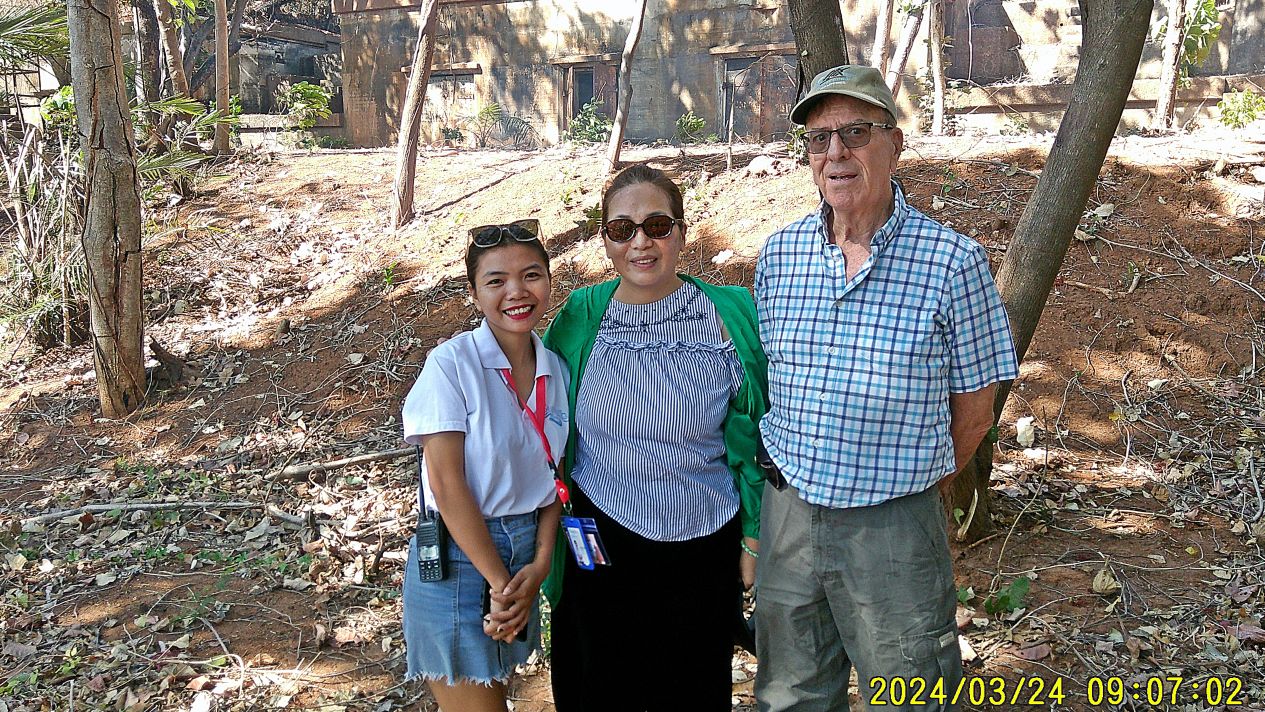
Z749 is in back of Battery Jewell, our guide, at left, took us there via the Mine-Casemate and we met the spouse of the Grande Island Resort manager (off island today) and told her about our mission to deliver a book and she told us that a plan for a museum is in the works. Randy Anderson, the main person of creating the Hell Ship Memorial in Subic Bay, was my partner and is right in the picture.
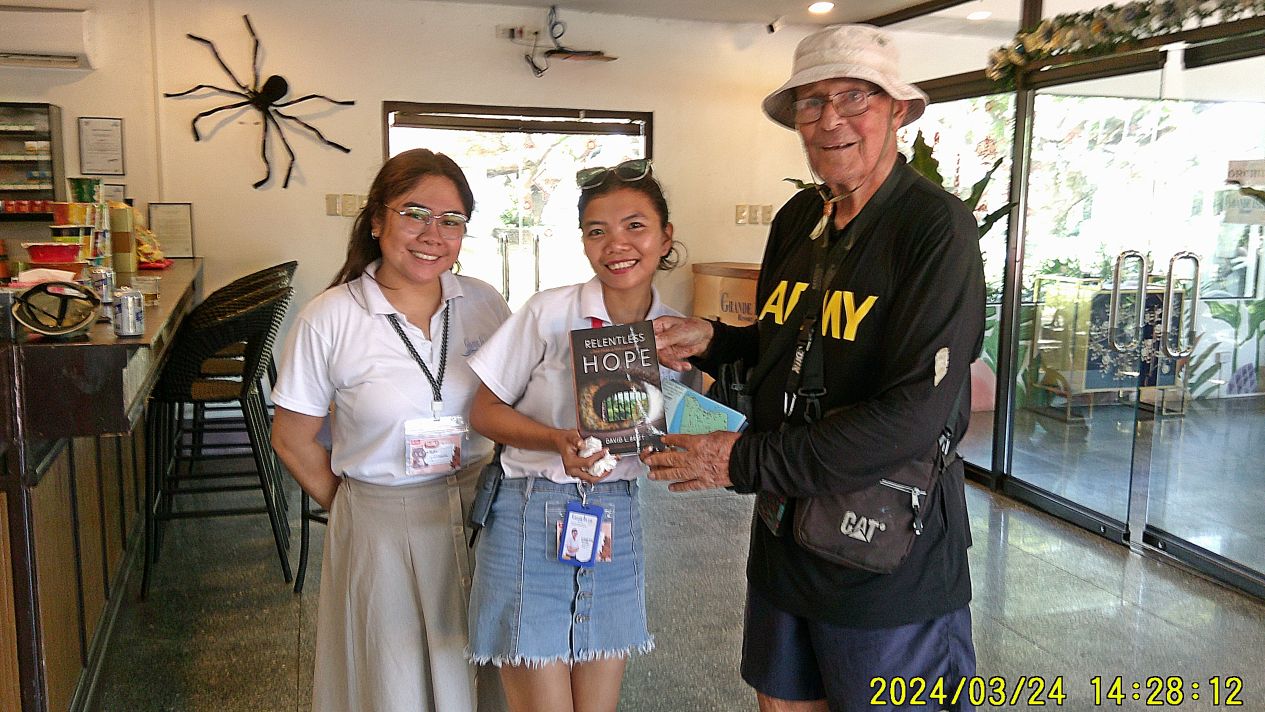
Z750 is in the dining hall, bar and event building, we are turning over the book Relentless Hope: A True Story of War and Survival, by David L. Britt, this is the front cover
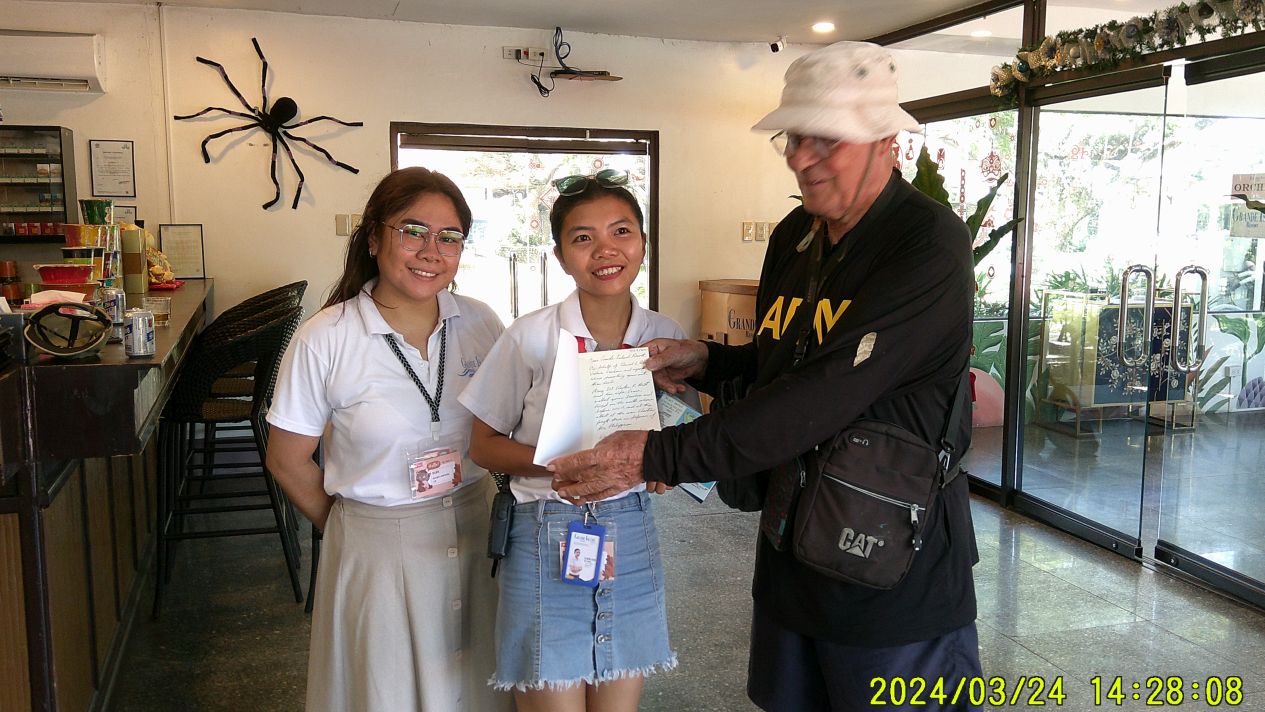
Z751 is in the dining hall, bar and event building, we are turning over the book Relentless Hope: A True Story of War and Survival, by David L. Britt, this is the dedication in the book to the resort.
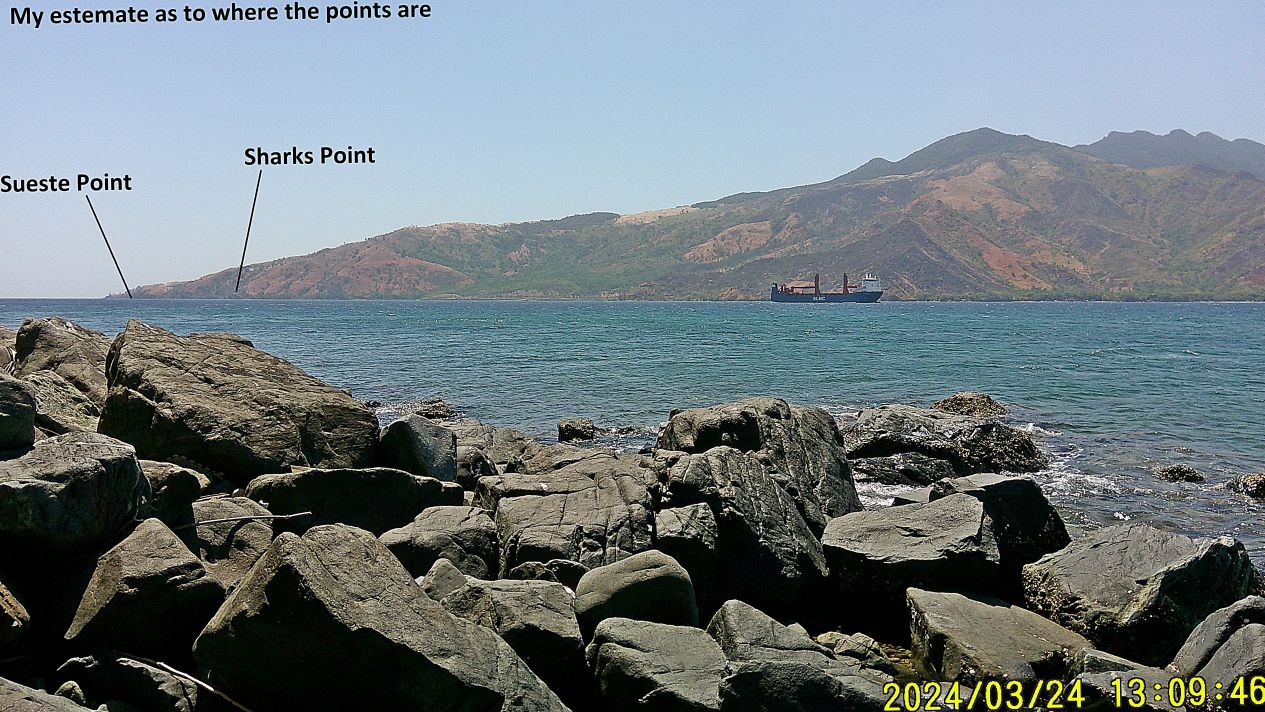
Z752 I had to walk over 100 meter over and on top of these rocks from the NW corner to reach this point on the Grande Island west coast to shoot this picture.
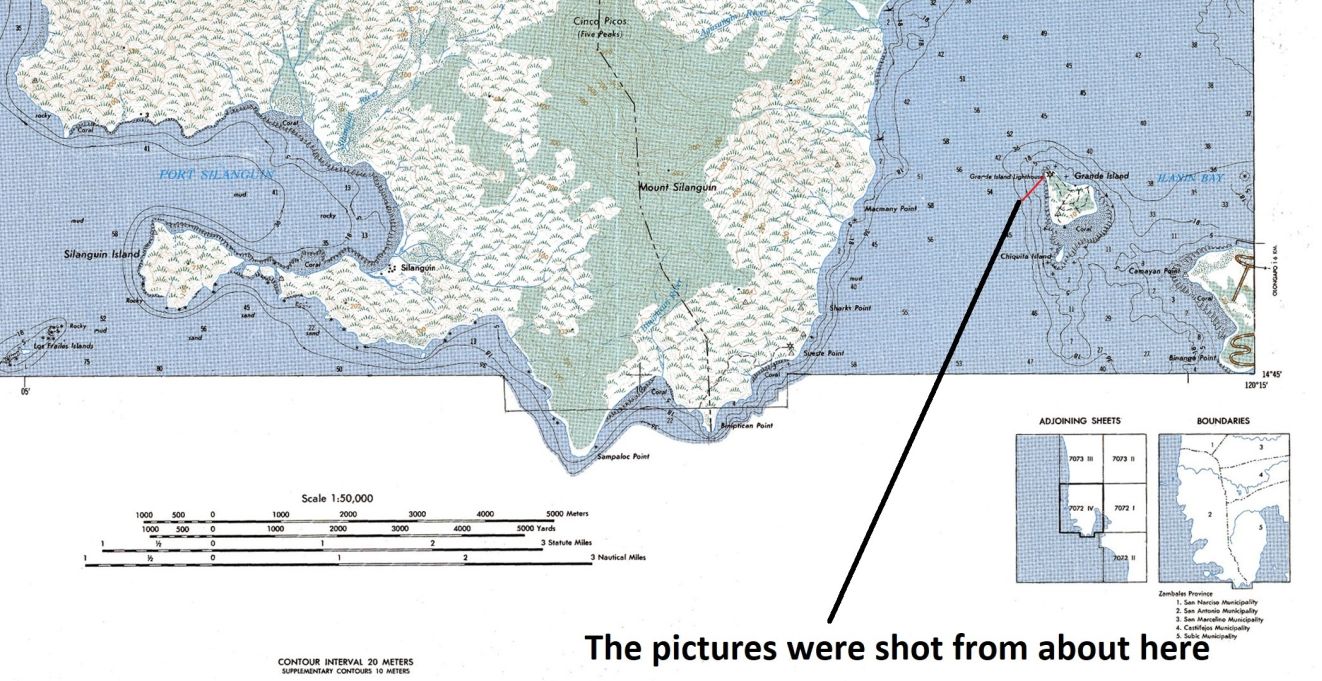
Z753. Is the bottom section of a the San Antonio 1-50000 map, 7072-IV, and shows the points, Grande Island and were I shot the pictures from.
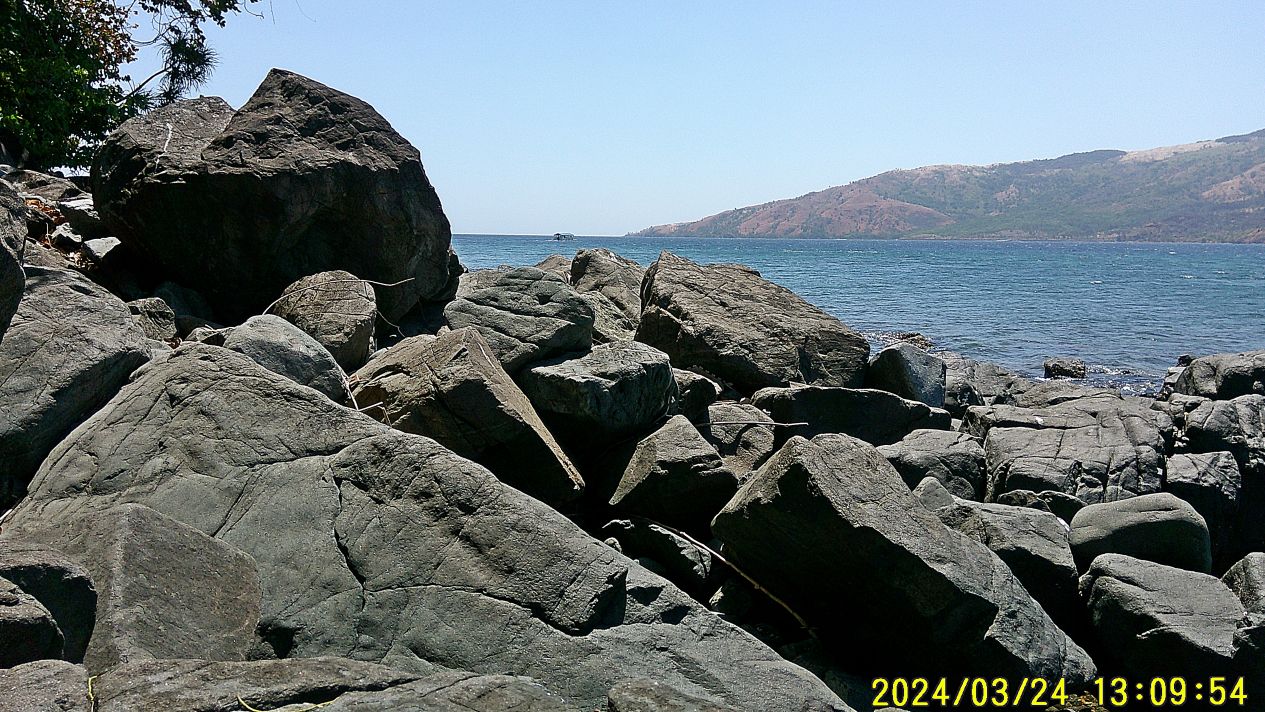
Z754. A boat crept into the picture and I could not help thinking about the shooting event on the 18th Dec. 1941 for the Battery Jewell getting the 3-inch coastal gun ready and receiving the order to fire at a Imperial Japanese Invading boat approaching Sueste Point.

